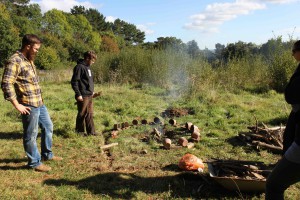I did my MA in Experimental Archaeology in 2006-7. Part of the course was two modules on communication and outreach; one for academic communications and one for working with the public. Part of the course was also to highlight experimental archaeology as a research method. I knew I liked the latter part better. To research on my own was my dream. I actually had this picture of myself with a box full of archaeological lithics that I would tip out on a table and peruse with a steaming mug of coffee and a notebook.
Post-MA, I started to do my own experimentation. I realised that to do archaeological experiments you needed space – it truly can be very gritty, messy, and smelly, and you would not want to use your office. I also realised that with space comes an audience. You are typically doing prep-work and experimentation either in a public or a shared space, where people regularly walk both by and into. That means you have to tell people what (the earth) you are doing. I soon came to realise that to work in a shared space is a very useful stimuli to my research, and it also felt good to see that others could be interested in my work.

As a part of my early experimental career, I twice executed own experiments at Land of Legends in Lejre, Denmark. Land of Legends was founded as an archaeological research centre in 1964, and has later evolved into a shared space for research and visitation. In this space – now formed as an open air museum – researchers have since the 60’s performed experiments in front of an audience who are intentionally visiting to see experimentation in practice. We should have enough experience from crafts demonstrations in archaeology by now to know that visitors like to see action in practice, but the performance of a research experiment in front of an audience adds another layer to the visitor’s experience, as people are stimulated to ask their own interpretive questions and enter into discussion with the archaeologist directly. But, what is less often highlighted is the other layer it adds to the researcher’s own experience of the experiment, and how s/he would approach the entire topic and problem.
For me, personally, and the teams I have been working as part of, the presence of an audience has been a particularly valuable contribution to an experiment. It makes me think about why the experiment should be done, as this explanation is regularly called for. Also, the audience may open new lines of insight. Once, while experimenting with aceramic birch bark tar extraction at Lejre, a chemist from the conservation department of the National Museum of Copenhagen came by, and stayed for hours while us experimenters discussed and learned about the chemical prerequisites for the necessary procedures to occur. Other parts of the audience have been crafts specialists, such as the pyro-technological insight of a professional potter. But in general, the questions vary from “what is that” to “have you thought about adding…” (these two opposites are actually very frequently posed); and from “can I do it” to “Would you like to try?” – “No thanks.” The various research teams and experiments I have been part of have ranged from the total and necessary exclusion of spectators, to the total and obligatory inclusion of spectators. Even when I have experimented in private space, such as a garden, we have invited people to witness and opine on our procedures. Even if outsider’s suggestions are not particularly helpful, we have honed our own argumentation of the research problem to perfection.
My various positive experiences from working in groups and inviting the audience in has made it hard for me to experiment on my own. To me, it feels rather lonely, and I am also not able to gauge interest for my topic in the same way. There are no stimulating discussions around my topic, and my arguments stay the same, and they are not necessarily very good. I have therefore sought out an audience by including for instance students, friends or colleagues. I prefer to be able to bounce ideas off others, and others seem to like to be present to discuss my research problems with me. It has made me think more broadly about issues relating to my experimental questions, and sometimes has turned the experiment in new directions entirely. It is of course also personally rewarding to get the acknowledgement of others. As part of my PhD, only one of the four case experiments I set up have been executed by me alone, and to be honest, this is the experiment that means the least for me emotionally. I literally feel that it has not been approved, and is therefore less interesting than the three others that have gotten quite a good audience response.
Although this is not necessarily the case technically, I have become an experimental team worker. Especially since I am not a technological specialist, but rather have my specialty in the methodology itself, I have not taken part in the crafts environment that an experimental archaeologist is often a member of. For me, the audience has become my social environment and has the same functionality as a discussion between technological colleagues: I discuss my ideas with non-archaeological friends, I have learnt about chemistry, beer brewing, food plants, materials engineering, and archery, and I have taught and explained experimental archaeology in return. This dynamic environment has not only made me a better experimenter, but a better archaeologist. I have been enabled with the understanding that our professional understanding is not necessarily better, only different. I am able to justify what I do to its fullest extent. And in doing so, I have had so much fun I can barely begin to describe it.
Tine Schenck is a Norwegian archaeologist with a specialism in the experimental methodology in archaeology.
